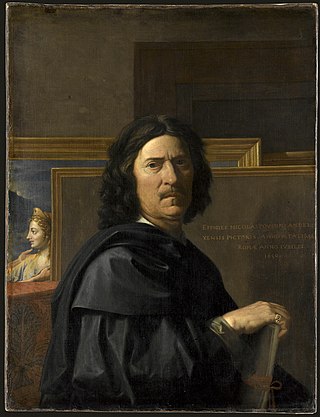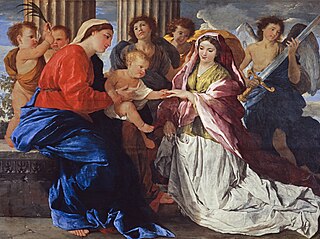Related Research Articles

Nicolas Poussin was a French painter who was a leading painter of the classical French Baroque style, although he spent most of his working life in Rome. Most of his works were on religious and mythological subjects painted for a small group of Italian and French collectors. He returned to Paris for a brief period to serve as First Painter to the King under Louis XIII and Cardinal Richelieu, but soon returned to Rome and resumed his more traditional themes. In his later years he gave growing prominence to the landscape in his paintings. His work is characterized by clarity, logic, and order, and favors line over color. Until the 20th century he remained a major inspiration for such classically-oriented artists as Jacques-Louis David, Jean-Auguste-Dominique Ingres and Paul Cézanne.
Ordination is the process of consecrating clergy.

Cassiano dal Pozzo was an Italian scholar and patron of arts. The secretary of Cardinal Francesco Barberini, he was an antiquary in the classicizing circle of Rome, and a long-term friend and patron of Nicolas Poussin, whom he supported from his earliest arrival in Rome: Poussin in a letter declared that he was "a disciple of the house and the museum of cavaliere dal Pozzo." A doctor with interests in the proto-science of alchemy, a correspondent of major figures like Galileo, a collector of books and master drawings, dal Pozzo was a node in the network of European scientific figures.
The expression seven sacraments mainly refers to:
Events from the year 1637 in art.
Events from the year 1648 in art.
Events from the year 1644 in art.
Jutta Koether is a German artist, musician and critic based in New York City and Berlin since the early 1990s.

Paul Fréart de Chantelou was a French collector and patron of the arts. He encouraged major artists of his era, in particular Nicolas Poussin (1594–1665) and Gian Lorenzo Bernini (1598–1680), and is known for his diary describing Bernini's visit to Paris in 1665.
Robert Jarman is an Australian theatre artist based in Hobart, Tasmania. Primarily a director and actor, he is also a writer and designer.

The Funeral of Phocion is a 1648 landscape painting, also known as The Burial of Phocion, Landscape with the Funeral of Phocion and Landscape with the Body of Phocion Carried out of Athens, by the French artist Nicolas Poussin. Phocion was an Athenian statesman from the 4th century BC.

The Four Seasons was the last set of four oil paintings completed by the French painter Nicolas Poussin (1594–1665). The set was painted in Rome between 1660 and 1664 for the Duc de Richelieu, the grand-nephew of Cardinal Richelieu. Each painting is an elegiac landscape with Old Testament figures conveying the different seasons and times of the day. Executed when the artist was in failing health suffering from a tremor in his hands, the Seasons are a philosophical reflection on the order in the natural world. The iconography evokes not only the Christian themes of death and resurrection but also the pagan imagery of classical antiquity: the poetic worlds of Milton's Paradise Lost and Virgil's Georgics. The paintings currently hang in a room on their own in the Louvre in Paris.
By his absolute humility, by his effacement of himself, by his refusal to use any tricks or overstate himself, Poussin has succeeded in identifying himself with nature, conceived as a manifestation of the divine reason. The Seasons are among the supreme examples of pantheistic landscape painting.
Jamais peut-être, dans toute la peinture occidentale, des choses aussi nombreuses et parfois si difficiles n'avaient été dites avec une telle simplicité. Jamais un peintre ne s'était aussi pleinement identifié à l'ordre du monde. Mais cette identification n'est ni « une projection » ni une confidence : là est le sens de cette impersonalité que l'on a pu reprocher à Poussin, et qui fait sa grandeur.

The Seven Sacraments refers to two series of paintings of the seven sacraments by the French painter Nicolas Poussin.

Landscape with Orpheus and Eurydice is a 124 × 200 cm oil-on-canvas painting by the French artist Nicolas Poussin, painted between 1650 and 1653. It depicts a mythological subject in the classical style and is in the collection of the Louvre in Paris.

The Inspiration of the Poet is an oil-on-canvas in the classical style by the artist Nicolas Poussin, painted between 1629 and 1630. It is held and exhibited at the Louvre, in Paris.

Extreme Unction is one of a set of seven scenes representing the sacraments of the Catholic Church, painted between 1638 and 1640 by the French artist Nicolas Poussin (1594–1665).

In 1845, the English-born Welsh architect Owen Jones designed an illustrated and decorated version of the 1662 Book of Common Prayer, the official prayer book of the United Church of England and Ireland. It was published in London by John Murray, with two new editions following in 1863.

The Mystic Marriage of Saint Catherine is an oil on panel painting by Nicolas Poussin, dated to about 1628–1629, which depicts the mystical marriage of Saint Catherine to Christ. The picture is now in the Scottish National Gallery, Edinburgh.

Eliezer and Rebecca or Eliezer Giving Abraham's Presents to Rebecca is an oil-on-canvas paintings by Nicolas Poussin, dating to c.1647–1649, commissioned by silk merchant and banker Jean Pointel and is now in the Louvre. Another similar version is at the Fitzwilliam Museum, whilst another is in a private collection and shows Rebecca quenching Eliezer's thirst rather than Eliezer giving the gifts.
References
- ↑ "The Seven Sacraments of Nicolas Poussin". www.artangel.org.uk. Retrieved 16 January 2025.